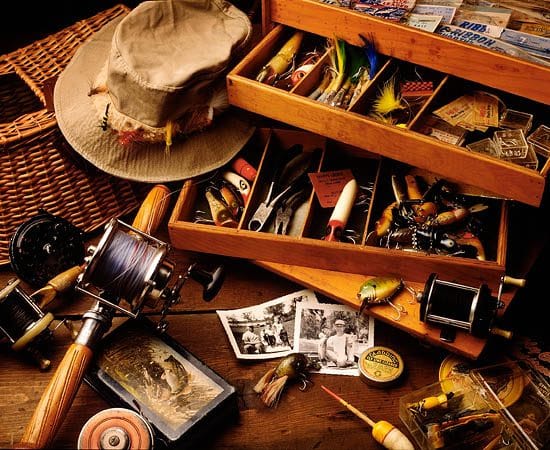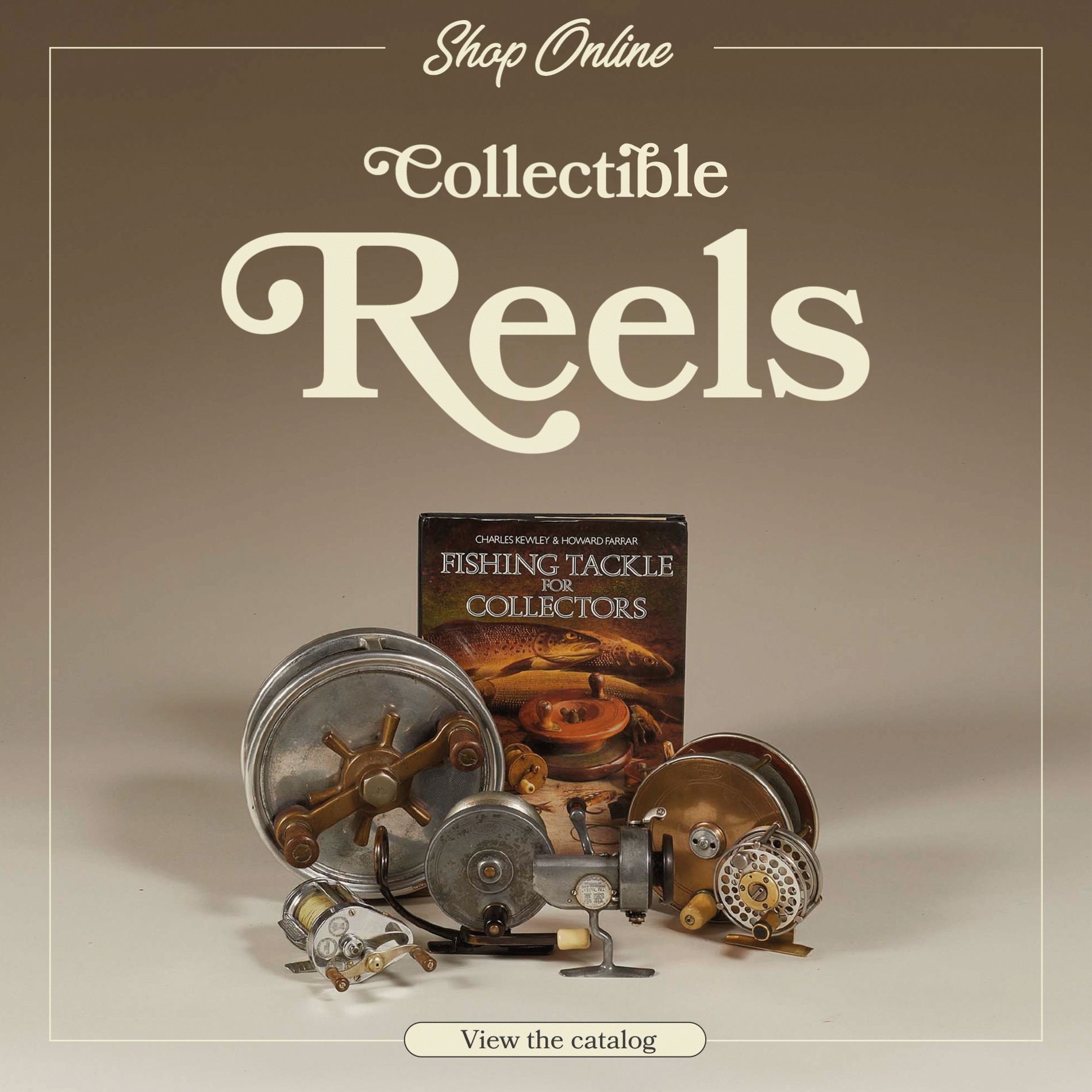
Fishing antiques and collectibles
Fishing antiques and collectibles

Much more than hunters, fishermen are collectors. Much more so in the Anglo-Saxon countries (United Kingdom, United States), Scandinavia and even in Japan, than here in France, where however, a few well-informed fishing tackle amateurs have started to build up fine collections in recent years.
There are two main reasons for this: on the one hand, fishing tackle (reels, rods, landing nets, gaffs, lures, flies, various accessories, etc. ) are infinitely varied, unlike hunting items which are much more limited (rifles, shotguns, decoys…), but above all, whereas a collection of beautiful hunting rifles can cost tens or even hundreds of thousands of euros, for fishing, the collector of lures or reels can enjoy himself for free or with a few dozen euros in his pocket, while browsing at flea markets, or even visiting his grandfather’s attic… If your father or grandfather was a fly fisherman or a caster, you may even discover in an old bag, reels or boxes of flies or lures dating from before the war. At the time, many reels and lures were imported from England or the United States, and if they are in good condition, they can represent very nice sums of money on the collector’s market.

Wooden and copper reels, split bamboo or Hickory rods, wooden fly boxes, all typical material of the twenties or thirties of the last century.
How to appreciate the age and the rating of a fishing object?

A whole assembly very disparate and more decoration than collection: rod and reel for sea fishing, old lures out of wooden for the river, stopper of fishing to the blow, hat of fisherman to the fly, wicker basket, all the fishing practices are evoked here with aestheticism.
The best way to know the date of manufacture and therefore of marketing of a rod, a lure or a reel, is to find in the fishing magazines of the past, the first advertisement (we spoke about advertisement before the war) concerning this object. The month and year of publication of the magazine (the first ones date back to 1880) will give you very precise information. From the beginning of the 20th century, the monthly magazines “La Pêche illustrée”, then “La Pêche indépendante” and “Au Bord de l’Eau” are a real mine of information for French fishing tackle manufactured between 1900 and 1960.
The factory catalogs (Pezon et Michel, Perrot) or distribution catalogs (Manufrance, Au Pêcheur écossais, Wyers, etc.) are also very precious. More recently, in view of the small craze for “fishing” collecting, many books in French, devoted to reels, rods, and especially lures, have been published. Some of them in small format, are practical to carry easily in the pocket, when you go to flea markets or yard sales. In addition to the precise description of the objects, rods, reels or lures, they generally give a quotation, very useful to have an idea of the current price, on the market of the collection, if not of the occasion.

Typical American fly fishing gear, especially the rattan basket lined with leather, with two pictures of US presidents who are passionate about fishing: Eisenhower and Truman and a badge with the effigy of Jimmy Carter, also US president and talented fly fisherman.
Beautiful antique fishing tackle can be eminently collectible.

A leather wallet and parchment pouches containing flies mounted on gut, a copper reel with natural silk line mounted on a split rod, an old landing net with wooden posts, all typical material of the beginning of the last century.
Even if they don’t always have a market value, old reels or rods, especially for fishing, made of reed or raw bamboo, which are often found in “faggots”, can be very interesting to decorate an old wall in a country house. The same is true of old wicker baskets, or so-called “live buckets” made of painted sheet metal, usually green, or raw zinc. If you find a lot of them, these buckets are of the most beautiful effect, simply put, on the right or on the left, on the steps of a staircase.
As for the “bottle traps” for gudgeon or minnows, in blown transparent glass, of which very few survived intact to the repeated shocks in the bottom of the rivers, they are there objects of collection, which arranged on a shelf, will intrigue your visitors.
I am always astonished, that the fishing rods, still called “cork fishing”, made of reed or bamboo, tied with brightly colored threads, which are lying around in the attics, are not highlighted, simply hung by two or three small nails on a wall, with some framed engravings of old magazines of the Chasseur Français, or other old fishing magazines…
The fishing objects, relevant to the collection, go from the old simple reels, out of wood, copper or bronze… and of course the old reels multipliers or with “fixed-drum”, dating from the Fifties or Sixties, without forgetting of course, the models for fly for trout or salmon…, of which some of English or American manufacture, which were imported in France, are worth small fortunes. Up to several tens of thousands of euros, each for some models of Hardy brand in particular… From 1970, for the reels, you will generally find only “Japanese” brands, globalization obliges, which have no interest to put in a window. For rods, those worthy of being collected and cherished, whether they are fly or spinning rods, are easily recognizable by their split bamboo construction, generally blond or amber in color, with fine silk ligatures, most often green or red in color. Before split bamboo, but more difficult to find, as they were mostly made in England or America, greenheart or “spearwood” rods, dating from the 1850s, became rare items, although less beautiful than split bamboo rods.

A nice "decorative" display of vintage fishing equipment: pre-war rod and reel, many old lures, superb brass telescopic gaff, plugs, Ogden Smith catalog of salmon flies, advertisements, etc.
Modern material imported from Southeast Asia is of no interest to the collection.

The English firm Westley Richards is better known as a manufacturer of quality rifles and shotguns than for its fishing tackle. Nevertheless, before the war, it marketed some nice fly rods and split shot rods, as well as reels "copied" from the Hardy range ....
From 1960, fiberglass, hollow or solid, replaced split bamboo, for casting and fly rods and especially after 1976, almost all products until today, are made of carbon fiber, even Kevlar for some brands. These rods industrially built in Southeast Asia, have obviously no interest for the collection. To return to the split rods, especially for fly fishing, but also for ultra-light casting, they are currently experiencing a clear revival of interest among English and especially American anglers, not to say fashion. It is true that for models under ten feet, or about three meters and of course models of 6 to 8 feet, these rods compete in all respects with the best carbon fiber models, and that in addition, the beauty of the object, there is no need to even mention it
The paradox is that today a fly rod of a renowned American or English brand in carbon fiber, costs in general twice as much as an equivalent model in second hand (often almost new in bamboo)… Understand who can….but we will come back to it….
In our country, some expert fly fishers, in the wake of the Americans or the English, are starting to collect and especially to fish with bamboo rods. It is true that from the end of the 30’s to 1980, that is to say during a good half-century, the House of Pezon & Michel of Amboise, manufactured thousands and thousands of split bamboo fly rods and spinning rods, which for the majority of the models were largely worth the best English models of the famous Hardy firm. Considering their high price (but very justified) at the time, these rods were almost always very well maintained and kept by their users, which explains why we still find, today, excellent models in perfect condition, (the famous “Parabolic” and PPP) to fish and or collect…The two being by no means incompatible. And the icing on the cake, but we have already said it, for a price often less than half of a new carbon fiber rod manufactured in large quantities in Korea or Singapore.

In a country house, or even a fishing lodge, an old wooden shelf, a nice wicker basket, two or three landing nets, one or two old rods, a few lures, an old gaff and three or four vintage reels, all artistically arranged, are of the most beautiful effect.




